Lately I’ve been having a lot of conversations around investment terms with searchers, as well as investors.
About 15 years ago, I interned at a search fund. And, over the last few years, I’ve started to invest in the asset class going direct as well as through funds of search funds.
Investing in search funds is a great way to scratch my entrepreneurial itch, extremely rewarding when a searcher finds success, and can be economically rewarding too.
This post is my attempt to share thoughts on self funded search economics in an effort to contribute to the search fund community, get feedback on my thinking from a wider audience, and of course meet more people who are doing searches/investing and may want to collaborate (please feel free to reach out!).
You can watch a video of me explaining this model here, and download the excel here:

Enterprise Value
The standard finance equation is enterprise value = debt + stock – cash. Enterprise value is how much the company itself is worth. Many times people confuse it with how much the stock is worth and find the “minus cash” part of this really confusing.
So, you can rearrange this equation to make it stock = enterprise value – debt + cash. Make more sense now?
Enterprise value is just how much you’re willing to pay for the company (future cash flows, intellectual property, etc), not the balance sheet (debt and cash).
Most investors and searchers think about the EBITDA multiple of a company on an enterprise value basis because they’ll be buying it on a cash free, debt free basis. It becomes second nature to think about EBITDA multiples and know where a given business should fall given scale, industry, etc.
However, I believe this second nature way of thinking of things can be a massive disadvantage to investors given the way EV and multiples are talked about in our community currently.
Sources of capital, the typical way to calculate enterprise value for self funded searchers
If you’ve ever looked at or put together a teaser for a self funded search deal, you will notice that the deal value is equal to the sum of the sources of capital minus deal fees and cash to the balance sheet.
As a simple example, if there is $4 mm of debt to fund the deal, $1 mm of equity, and $200k of deal fees, the enterprise value = $4 mm + $1 mm – 200k = $4.8 mm.
We’ll use slightly more complex numbers in our example: If a searcher is taking a $3.2 mm SBA loan, $850k seller note, putting in $120k themselves, getting $350k of equity from the seller, a $500k earnout, and $1.2 mm of equity financing minus $350k to the balance sheet and $250k of deal fees, then the enterprise value will be $5.62 mm.
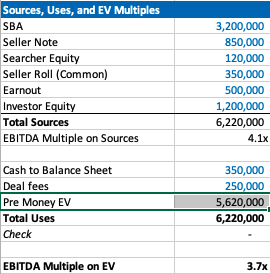
Our example company has $1.5 mm of EBITDA, so the EBITDA multiple is 3.7x. This is a pretty attractive acquisition multiple for a business that meets traditional search criteria (recurring revenues, fragmented competition, high gross margins, low customer concentration, etc).
If you’re seeing a search fund deal for the first time, the headline of “we’re buying a decent company for 3.7x, and replacing a tired owner with a hungry operator” is pretty exciting!
However, if you’re an investor, there is some nuance to this enterprise value number and the true EBITDA multiple you are investing in.
The trick with self funded enterprise value
The security that most self funded search investors get in a deal is participating preferred stock with a paid in kind dividend. This means when there’s an exit, you get your money back before any other equity holder, then get a certain percent of the business, and whatever dividend you’ve been owed in the interim accrues to your principle.
It’s a really favorable security for the investor, and one that is basically impossible to get in VC where straight preferred stock is much more common (no pun intended).
The key terms are what percent of common equity does this security convert into after the originally principal is paid back, and what is the dividend.
The share of common equity the investor group will get typically ranges from 10-50% of the total common stock. The dividend rate is usually 3-15%. The average I’m seeing now is around 30% and 10% for common and dividends respectively.
The strange this about the enterprise value quoted to investors in a teaser/CIM is that it doesn’t change as the percent of common changes, even though this has large implications for how much the common equity is worth and the value investors receive.
For example, I may get a teaser where the sources of investment – cash to balance sheet – deal fees = $3.7 mm for a $1 mm EBITDA company, which would imply a 3.7X EBITDA multiple. Let’s say the searcher is offering investors 30% of the common and a 10% dividend.
Let’s now say that the searcher is having a tough time raising capital and changes their terms to 35% of common and a 12% dividend. Does the effective enterprise value change for investors? I would argue yes, but I would be surprised to see it changed in the CIM/teaser.
This isn’t a knock on searchers or the search fund community. It’s just kind of how things are done, and I think this is mostly because it’s really hard to think about how the enterprise value has changed in this scenario.
However, the natural way of using EBITDA multiples to think about value for a business that is so common in PE/SMB can be extremely misleading for investors here. You may be thinking 3.7X for this type of business is a great deal! But, what if the security you’re buying gets 5% of the common?
If you’re in our world, you may counter this point by saying most searchers will also supply a projected IRR for investors in their CIM. However, IRR is extremely sensitive to growth rate, margin expansion, and terminal value. While the attractiveness of the security will be reflected, it can be greatly overshadowed by lofty expectations.
To get more clarity and have a slightly different mental model on the effective price investors are paying for this business, let’s go back to basics. Enterprise value should be debt + preferred stock + common stock – cash.
We know the values of each of these numbers, except the common. So, the main question here becomes: how much is the common equity worth?
Calculating value of common equity for self funded search funds
Equity value for most search fund deals = preferred equity from investors + the common equity set aside for the searcher and sometimes also advisors, board, seller.
We know that the preferred equity is investing a certain amount for a certain amount of common equity. The rub is that they are also getting a preference that they can take out before any common equity gets proceeds, and they are getting a dividend.
So, the exercise of valuing the common equity comes down to valuing the preference and dividend.
In my mind, there are three approaches:
- The discount rate method where you take the cash flows you’ll get in the future from the pref/dividends and discount them back at the discount rate of your choice. I am using 30% in my model which I believe accurately compensates investors for the risks they are taking in a small, highly leveraged investment run by an unproven operator. If you believe in efficient markets, this number also fits as it mirrors the historical equity returns as reported by the Stanford report, with a slight discount given this asset class has clearly generated excess returns relative to other assets on a risk adjusted basis, hence interest in these opportunities from an expanding universe of investors.
- The second method is to calculate how much money you’d get from your preference and dividends, taking into account that per the Stanford study around 75% of search funds will be able to pay these sums, and then discount these cash flows back at a rate more in line with public equities (7% in my model). This yields a much higher value to the preference/dividend combo, and therefore lowers the implied value of the common equity.
- The last method is to just say nope, there is no value to the preference and dividend. I need them and require them as an investor, but they are a deal breaker for me if they aren’t there, and therefore they don’t exist in my math. This of course makes no logical sense (you need them, but they also have no value?), but I’ve left it in as I think many investors probably actually think this way and it creates a nice upper bound on the enterprise value. Side note, as with obstinate sellers, jerk investors are usually best avoided.
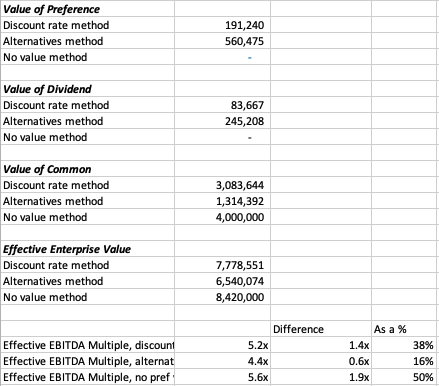
In our example, you can see a breakdown of the preference value, dividend value, and therefore common value and enterprise value for this deal.
In each case, the effective EBITDA multiple moves from 3.7x to something much higher (see the last 3 lines).
There are some simplifying assumptions in the model (no accruing dividend, all paid in last year), and some weird stuff that can happen (if you make the hold time long and the dividend greater than the 7% equity discount rate, the value of the dividend can get really big).
These flaws aside, I think this creates a nice framework to think through what the common is actually worth at close, and therefore what enterprise value investors will be paying in actuality.
It’s worth noting that the whole point of this is to benchmark the value you’re getting relative to market transactions in order to understand where you want to deploy your capital.
This creates a method to translate cash flow or EBITDA multiples of other opportunities on an apples to apples basis (if only there were a magical way to translate the risk associated with each as well!).
Another note, we could calculate the value of the common to be what this asset would trade at market today in a well run auction process minus any obligations (debt, preference, seller financing). However, I think that understates the option value inherent in this equity, a value that is only realized when a new manager takes over with more energy and know how.
There is a finance nerd rational for this. If you plot the value of equity in a leveraged company on a chart, it mirrors the payout of a call option. In both cases, the value of the security increases at a certain inflection point: when the value of equity rises above the strike price in an option, and when the enterprise value of a company rises above the debt level in a levered company.
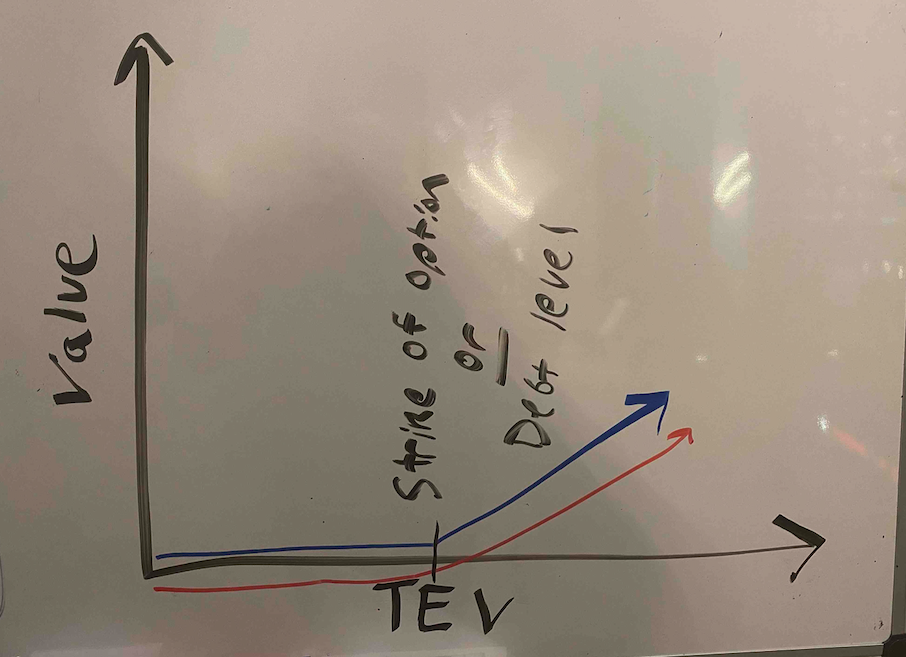
The common equity of a highly levered company can therefore be valued by a similar methodology as the call option: Black Scholes. If you remember back to finance class, increasing volatility will increase the value of an option.
In the search fund case, we’ve (hopefully) increased the (upside) volatility and therefore create more value than simply selling the company today.
A few more thoughts on investor economics
There are a few other ways to think about the economics you get as an investor to best understand if this is the deal for you.
First, you may want to think about how much your investment will be worth day 1. The key lever in this model is what discount this company is being bought for relative to fair market value. For example, the searcher may have proprietary sourced a great company and is buying it for 25% below what it would trade at in a brokered auction.
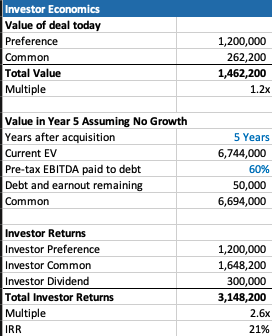
This is very much a “margin of safety” philosophy on things. Same with the calculation on how much you’ll receive in year 5 (after QSBS hits) assuming no growth in the business.
The only problem with each of these calculations is that they never play out in practice. Most companies don’t just stay the same, you’re either in a rising tide or you’re in trouble. And, you’re almost never going to sell in year 1, and definitely not for a slight premium to what it was bought for.
However, if your investment is worth 30% higher day one, and you can make a 20% IRR assuming nothing too crazy happens either way in the business, that’s not a bad place to start. Add in a strong searcher, decent market, some luck, and you’re off to the races.
Thoughts on searcher economics
A lot of this post has considered things from the investor perspective as my main quandary was related to how to create an EBITDA multiple that made sense for investors.
However, the point of this post is not to say searchers are misrepresenting or being unrealistic with their terms. In fact, I think it’s quite logical that self funded searchers capture the massive economic value that they do.
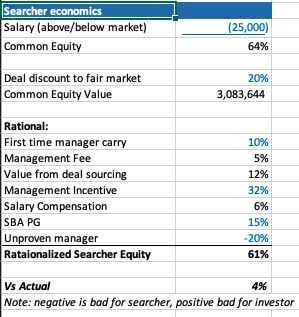
There are many reasons why self funded searchers deserve the lion share of the common equity.
First, they are providing a nice service of giving investors a positive expected value home to park their money with much lower correlation to the market than other asset classes ($1 mm EBITDA companies don’t see lots of multiple contraction/expansion throughout cycles).
Most money managers that fit that criteria are taking a 2/20, of course they also usually have a track record. So, I’ve used a 10% carry in my model, but stuck to 2% annual management fee.
The searcher spent a lot of time, and probably money, finding this company. That’s a lot of value, especially if it’s a below market price. They should be able to capture a lot of the value in finding a below market deal.
The searcher may be taking a below market salary, and needs to get comped like any CEO, with stock options. In my example model I have $1 mm of stock vesting over the hold period, as well as extra comp for taking a below market salary.
Searchers are also usually putting their financial standing at risk by taking a personal guarantee on the bank/SBA loan. This is really tough to put a number on, as is the last line in my framework where searchers are dinged for lack of experience. Like any good model, you need a few lines that you can fudge to make the math work 🙂
What you do think?
I’m shocked that I wrote all this. I was going to type a few paragraphs and a quick excel. However, putting this to paper has been a great exercise for me to sharpen my thinking.
Now I’d like you to help me further. Where do you think this should be changed in this framework? How do you think about things from the investor and/or searcher side?
Feel free to shoot me a note if you have thoughts (even just to tell me I’m being way too academic with this, which I actually agree with).
Lastly, a post like this is really a trap I’m putting on the internet to catch any like minded people in so that we can figure out ways to collaborate now or in the future. So, at the very least, connect with me on LinkedIn 🙂
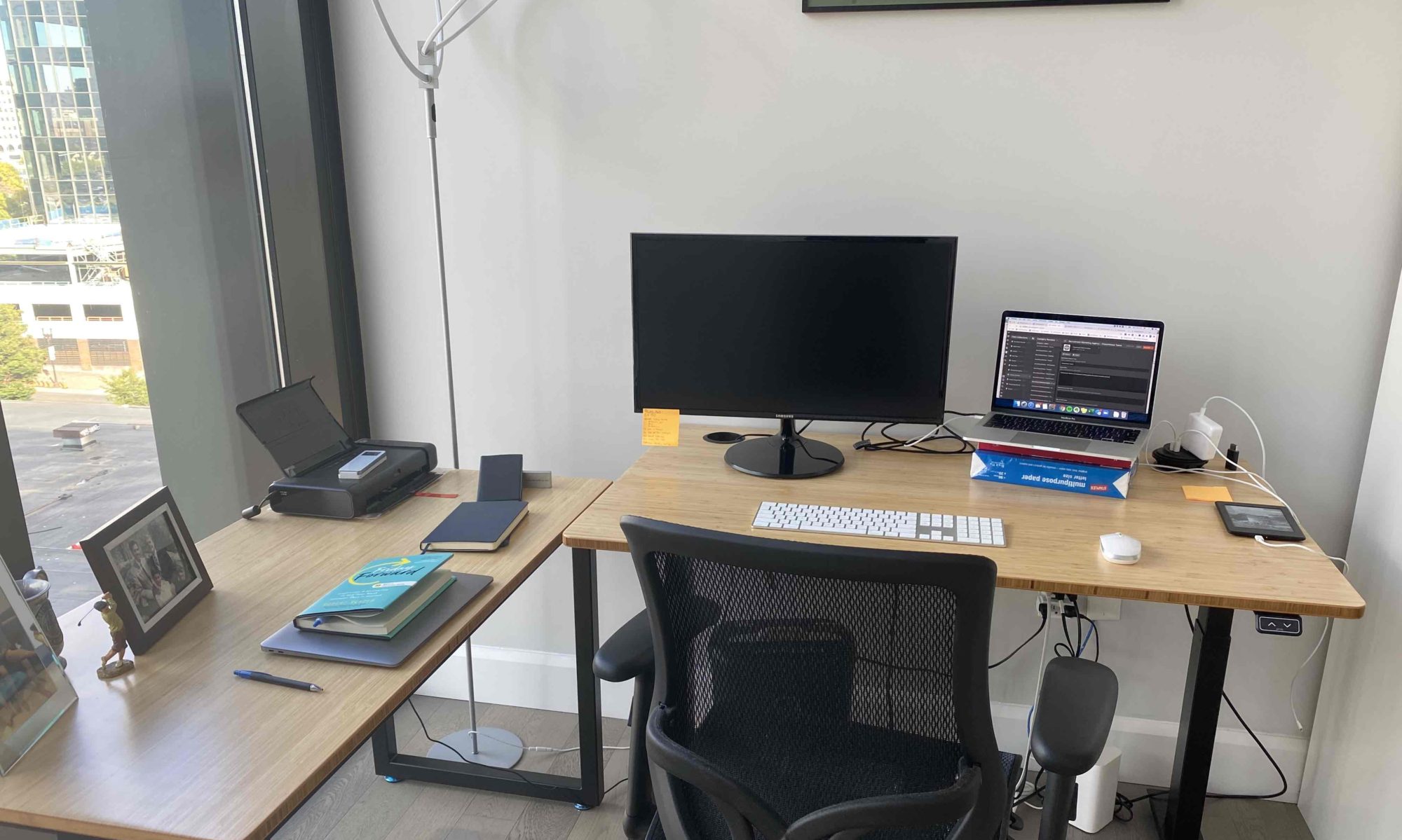
I was curious if you ever considered changing the layout of your website?
Its very well written; I love what youve got to say.
But maybe you could a little more in the way of content so people could connect with it better.
Youve got an awful lot of text for only having
1 or 2 pictures. Maybe you could space it out better?
I’ve been exploring for a little bit for any high-quality articles or weblog posts
on this sort of area . Exploring in Yahoo I finally stumbled upon this website.
Reading this info So i am happy to express that I
have an incredibly excellent uncanny feeling
I found out just what I needed. I most surely will make sure to don?t disregard this web site and provides it a glance on a constant basis.
Heya! I realize this is sort of off-topic however I had to ask.
Does operating a well-established blog like yours take a massive
amount work? I’m brand new to operating a blog however I do write in my journal everyday.
I’d like to start a blog so I will be able to share my personal experience and thoughts online.
Please let me know if you have any recommendations or tips for brand new aspiring bloggers.
Appreciate it!
Hey there! I simply want to give you a big thumbs up for
the excellent information you’ve got here on this post.
I’ll be coming back to your site for more soon.
Amazing blog! Do you have any helpful hints for aspiring writers?
I’m planning to start my own website soon but I’m a
little lost on everything. Would you propose starting with a free platform like WordPress or go for a paid option? There are so many options
out there that I’m totally overwhelmed .. Any tips?
Many thanks!
No matter if some one searches for his required
thing, therefore he/she wants to be available that in detail, thus
that thing is maintained over here.
There’s certainly a great deal to learn about this subject.
I like all of the points you’ve made.
What’s up it’s me, I am also visiting this web site daily, this site is truly nice and the
users are truly sharing nice thoughts.
Good post. I will be dealing with many of these issues as well..
I used to be suggested this website by means of my cousin. I’m no longer certain whether or not this post is written by way of him as no one else know such certain approximately my problem.
You’re wonderful! Thanks!
Highly descriptive article, I liked that bit. Will there be
a part 2?
My partner and I stumbled over here different website and thought I should check things out.
I like what I see so now i’m following you. Look forward
to looking into your web page repeatedly.
No matter if some one searches for his necessary thing, so he/she
wishes to be available that in detail, therefore that thing is maintained over here.
It’s really a nice and useful piece of information. I’m happy that you simply shared this helpful info with us.
Please stay us informed like this. Thank you for sharing.
I’m not sure why but this weblog is loading incredibly slow for me.
Is anyone else having this problem or is it a issue on my end?
I’ll check back later and see if the problem still exists.
It is appropriate time to make a few plans for the long run and it’s time to be happy.
I’ve read this publish and if I may just I want to counsel you few interesting issues or tips.
Maybe you could write subsequent articles referring to this article.
I wish to read more things approximately it!
Having read this I believed it was very enlightening. I appreciate you finding the time and energy
to put this short article together. I once
again find myself personally spending way too much time both reading
and posting comments. But so what, it was still worthwhile!
I am regular visitor, how are you everybody? This post posted at this website is actually nice.
Every weekend i used to go to see this web site, for the reason that i want enjoyment,
for the reason that this this site conations really nice funny information too.
Hi, i feel that i saw you visited my web site so i came to return the desire?.I
am attempting to in finding issues to enhance my site!I assume
its ok to make use of some of your concepts!!
I’m not that much of a internet reader to be honest
but your blogs really nice, keep it up! I’ll go ahead and bookmark your website to come back down the road.
All the best
We are a group of volunteers and starting a new scheme in our community.
Your website offered us with valuable information to work on. You’ve done a
formidable job and our whole community will be thankful to you.
wonderful put up, very informative. I wonder why the opposite
experts of this sector don’t understand this. You must proceed your
writing. I am confident, you have a huge readers’ base already!
Do you mind if I quote a few of your articles as long as I provide credit and sources back to your site?
My website is in the very same area of interest as yours
and my users would genuinely benefit from some of the
information you provide here. Please let me know
if this ok with you. Cheers!
Hi there i am kavin, its my first occasion to commenting anywhere, when i read this paragraph i
thought i could also make comment due to this sensible article.
That is a good tip particularly to those fresh to the blogosphere.
Simple but very accurate information… Appreciate
your sharing this one. A must read post!
It’s remarkable for me to have a web site, which is helpful for my
know-how. thanks admin
That is a really good tip particularly to those new to
the blogosphere. Brief but very precise info… Thank you for sharing this one.
A must read post!
I think the admin of this website is really working hard in favor
of his web page, since here every data is quality based information.
Hi! I just wanted to ask if you ever have any
trouble with hackers? My last blog (wordpress) was hacked and I ended
up losing months of hard work due to no backup.
Do you have any solutions to prevent hackers?
I always spent my half an hour to read this weblog’s articles or reviews daily along with a cup
of coffee.
This blog was… how do you say it? Relevant!! Finally I’ve found something
that helped me. Cheers!
This is a really good tip particularly to those fresh to the blogosphere.
Simple but very accurate info… Thanks for sharing this one.
A must read article!
I believe this is among the such a lot important information for me.
And i am satisfied studying your article. However wanna
statement on some common issues, The web site style is great,
the articles is in point of fact excellent : D. Good activity, cheers
Hast du Kriegen wollen relaxtes Kochen? Du schmeckst nicht nur zur Partyzeit.
„O Tannenbaum, o Tannenbaum, wie knusprig sind deine
Blätter. Nein, auch zwischendurch, wenn der Magen nach etwas Leckerem schreit”, ich letzte Woche beim Backen. Dein Glück, dass du meine schiefen Töne ungehorsam sein musstest. Der Mann hat mich sichtlich gequält und mit hochgezogenen Augenbrauen angeguckt. Ok, ich kann vielleicht beharrlich schweigen. Und wie ich backen kann – siehe meinen Blätterteig Tannenbaum. Aber dafür kann ich backen! Dass dieses Fingerfood supereinfach gemacht ist, muss ja niemand wissen. Neben süßen Weihnachtspralinen und leichten Vanillekipferln ist es gut aufgehoben. Ich glaube ja, dass das Bäumchen aufm Tisch massig hermacht. Dann kannst du süß und herzhaft im Wechsel naschen. Herzhaft, weil der Blätterteig Tannenbaum mit Pesto „gefüllt” ist – yummy!
Wie du das einfach machst? Mit selbst gemachtem Basilikumpesto bestreichen und
einen zweiten Blätterteig darauflegen – Weg.
Fertigen Blätterteig aus dem Kühlregal ausrollen. Ich greife hier bewusst zu fertigem Blätterteig.
Damit geht’s einfach viel schneller und schmeckt mindestens nicht minder, wie der Selbstgemachte.
Hello, Neat post. There’s an issue together with your web site in internet explorer, may check this?
IE nonetheless is the market chief and a good portion of people will leave out your fantastic writing because of this
problem.
Thanks in support of sharing such a good idea, post is fastidious, thats why i have read it entirely
Every weekend i used to pay a visit this web page, because i wish for
enjoyment, for the reason that this this website conations in fact good funny stuff too.
May I just say what a relief to uncover somebody who really understands what
they’re discussing online. You actually realize how
to bring an issue to light and make it important.
A lot more people must check this out and understand this side of your story.
I can’t believe you’re not more popular given that you surely possess the gift.
I’ve been surfing online more than three hours nowadays, but I by no means found any
fascinating article like yours. It’s pretty worth sufficient for me.
In my opinion, if all site owners and bloggers made good content material as you did, the net
will likely be a lot more useful than ever before.
Greetings I am so excited I found your blog page, I really found you by error, while I was browsing on Aol for something else,
Anyhow I am here now and would just like to say thank you for a
fantastic post and a all round exciting blog (I also love the theme/design), I don’t have time to browse it all at the
moment but I have book-marked it and also included your RSS feeds, so when I have
time I will be back to read a lot more, Please do keep up the awesome jo.
Fastidious respond in return of this issue with solid arguments and explaining everything about that.
Hmm it seems like your site ate my first comment (it was super long) so I guess I’ll just sum it up what I submitted and
say, I’m thoroughly enjoying your blog. I too am an aspiring blog
writer but I’m still new to the whole thing. Do you have any points
for first-time blog writers? I’d definitely appreciate it.
Thanks for the marvelous posting! I seriously
enjoyed reading it, you can be a great author. I will be sure to bookmark your blog and
will eventually come back at some point. I want to encourage you to ultimately
continue your great writing, have a nice weekend!
Your mode of explaining the whole thing in this article is actually nice, every one can simply know it, Thanks a lot.
I was wondering if you ever considered changing the layout
of your blog? Its very well written; I love what youve got
to say. But maybe you could a little more in the way
of content so people could connect with it better.
Youve got an awful lot of text for only having one or
two images. Maybe you could space it out better?
Hi to every body, it’s my first pay a visit of this web
site; this weblog carries remarkable and actually excellent stuff in support of readers.
Excellent post. I was checking continuously this blog and
I am impressed! Very helpful info specially
the last part 🙂 I care for such information a lot. I was seeking this certain information for a long time.
Thank you and good luck.
Hi, i think that i saw you visited my website thus i came to “return the favorâ€.I’m attempting to find things to improve my site!I suppose its ok
to use some of your ideas!!
Sportart ist eine Sportart, die bei Erwachsenen in allen Altersgruppen sehr beliebt
ist. Nordicwalking ist einfach zu erlernen. Sie eignet sich auch für Menschen, die nach längerer Zeit in ein Training einsteigen möchten und oder nach einer Erkrankung
ihre Fitness wiedererlangen möchten. Sie benötigen keine speziellen Voraussetzungen oder Spezialkleidung und können das Zubehör einfach und schnell bei Sportco bestellen. Das wichtigste Sportgerät fürs Sportart
sind die Nordic-Walking-Stöcke. Am besten wählen Sie ein stufenlos einstellbares Modell.
Für den guten Halt sorgen Nordic-Walking-Handschuhe.
Diese sind besonders für lange Touren wichtig. Achten Sie auf
die richtige Nordic-Walking-Stocklänge; diese ist für die gesunde Ausübung der
Sportart sehr wichtig. Wenn Sie Handschuhe tragen, können Sie die Nordic-Walking-Stöcke besser halten.
Für verschiedene Untergründe benötigen Sie
spezielle Sport Pads, die Sie an den Nordic-Walking-Stöcken einfach wechseln können. Schrittzähler helfen Ihnen, den Überblick über
Ihre Leistung zu behalten. Für die Sicherheit rätselhaft sorgen Reflektoren und
Blinklichter. Das richtige Pad gibt Ihnen ausreichend Grip für die Ausübung des Sports.
Ein Elastikband zur Anbringung an einem Nordic-Walking-Stock ermöglicht ein zusätzliches Kraft-Widerstands-Training zum
Beispiel für die Arme.